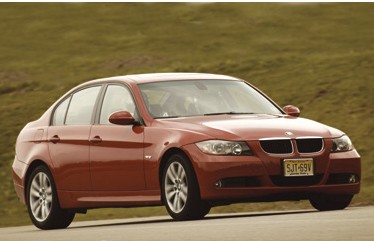



Back Country Journal
Presents:
BMW 3 Series Reviews (2008)
| BMW 1 Series | BMW 3 Series | BMW 5 Series | BMW 6 Series | BMW 7 Series |
| BMW Z4 | BMW X3 | BMW X5 | BMW X6 | BMW M Series |

2008
BMW 3 SERIES SEDANS AND SPORTS WAGONS
The
Best Is Now Even Better
For
2008, the best sports sedans and sports wagons in the compact luxury
segment
receive new equipment including optional transmission paddle shifters
mounted
behind the steering wheel available when the vehicle is equipped with a
6-speed STEPTRONIC automatic
transmission and the Sport Package. New 16-in
light alloy wheels are standard on with the 328i and 328xi Sedans. Those models now feature standard
chrome
tailpipe tips. In addition, HD Radio is
now available for less at $350.
EfficientDynamics:
Efficient
power
The
328i
The 335i and 335xi Sedans obtain their
motivation from the
3.0-liter twin-turbocharged inline 6-cylinder engine with a cast
aluminum
engine block producing 300 horsepower and 300lb-ft of torque. This is a 45 hp and 80 lb-ft of
torque
improvement
over the 2006 330i models.
The increase in horsepower and torque on
both of these
engines is not offset by a decrease in fuel efficiency.
The new engines have similar fuel economy as
the already impressive 2007 3 Series Sedans and Sports Wagons.
Drivers may specify the standard-
equipment
6-speed manual
transmission or the optional 6-speed STEPTRONIC automatic
transmission. The 335i/xi gear ratios
have been optimized to work with the new twin-turbocharged engine. The 335i and 335xi Sedans have steering
wheel-mounted paddle shifters when ordered with the optional Sport
Package and the
6-speed
STEPTRONIC automatic
transmission.
The BMW
twin-turbo 6-cylinder engine
It is the most powerful engine within
BMW's wide range of
inline 6-cylinder engines that does not wear an "M" badge.
The twin-turbo engine, designated N54,
develops a maximum output of 300 horsepower in
Although it is standard
equipment on its highly
acclaimed diesel engines, BMW has not used turbocharging with a
road-going
gasoline powerplant since the 1980's. Until
now, the BMW 745i
While the technology
works as advertised, BMW
engineers were not satisfied with the most often-cited downside to
turbocharging; the frustrating “turbo lag” that occurs when the driver
presses
the accelerator pedal and when the turbocharger develops sufficient
rotation to
increase power. Turbo lag is at its
worst at low engine speeds. Other
drawbacks included relatively high fuel consumption and poor emissions
output.
At the time, turbocharger technology was not a reliable, practical or
efficient
was to make power. For these and other
reasons, BMW put turbocharged gasoline engines on the shelf for more
than 20 years.
Two recent developments
caused BMW to reconsider
turbocharging. While many luxury-performance carmakers began to achieve
power
gains by building engines of ever-increasing displacement, BMW looked
for a
more efficient way with smaller engines and turbocharging made sense. Also, the technology transfer from BMW’s
turbocharged
diesel engines could easily be transferred to their gasoline-fired
counterparts.
Accordingly, BMW articulated its new approach to developing
high-performance
engines as part of its EfficientDynamics initiative.
The N54 features twin, relatively small
turbochargers to
boost performance significantly, but, at the same time, minimize turbo
lag. Thanks to their lower inertia, two
small turbochargers build up pressure much faster than a single, large
turbocharger, thus eliminating even the slightest lag.
A further in advantage of turbocharging is
that this is the
most weight-efficient to boost engine power and performance. The N54 turbocharged inline engine
weighs
approximately 150 lbs. less than an equally powerful eight-cylinder
engine
displacing 4.0 liters. This lower weight
means a significant advantage not only in fuel economy, but also in
balancing
the car's weight distribution.
To enhance efficiency, the turbochargers
are made of a
particularly heat-resistant material which makes them immune to high
exhaust
gas temperatures in the interest of a fuel-efficient combustion process
particularly under full load.
As a result, the twin turbo technology in
the BMW 335i/xi
Sedans represents a significant achievement in terms of both
performance and
fuel economy. The advantages over a conventional turbocharged engine
are not
only clearly measurable, but easy to feel on the road.
This high-performance engine develops its
power and
performance much more spontaneously than a turbocharged engine of
conventional
design. At the same time, the N54 engine
offers all the smoothness and refinement which made BMW's award-winning
inline
sixes so admired well. Last, but
certainly not least, the impressive increase in power on the twin-
turbo
engine
versus a normally aspirated six-cylinder engine comes without any
significant
increase in fuel consumption.
Turbocharging typically includes
intercooling of the
engine's induction air, in other words, cooling the compressed air
heated by
the combustion process, from the turbocharger(s).
Sometimes
that's accomplished with coolant;
in the case of the N54 engine, it's accomplished with outside air. Intercooling is desirable, often
necessary to
reduce the temperature of the incoming air to preclude detonation or
"knocking" that can reduce power or, in the extreme, damage the
engine. Of course, the N54, like the
normally aspirated N52 and other current BMW engines, is equipped with
knock
control.
As effective as the magnesium/aluminum
engine construction
is for saving weight, the significantly increased loads and cylinder
pressures
of the N54 300-horsepower engine required the use of an aluminum engine
structure with cast-iron cylinder sleeves. Some,
but not all, of the N52's magnesium/aluminum weight
saving was
lost in this process. All together, the
N54 weighs 419 lb; the N52 357.
A high-pressure direct fuel injection
system utilizing
so-called piezo injectors also enhances performance and fuel efficiency. A 2nd-generation evolution of the system
found on the BMW 760's V12 engine is a key factor in achieving BMW's
goals for
the N54. The system's in advance over
its predecessor is that it provides the engineers a greater degree of
freedom
in the calibration of fuel quantity and timing and the distribution of
the
fuel-air mixture in the combustion chambers.
A piezo injector, a recent advancement in
fuel injector
technology, uses an actuator that takes the place of the solenoid valve
in a
conventional injector. The actuator,
which works significantly faster than the solenoid, reduces the
injector's response
time. That results in, according to
researchers who led the piezo injector's development, a 2 - 3% fuel
savings and
20% less emissions.
For the first time in a 3 Series
Performance
improvements
The engines
deliver impressive 0-60 mph acceleration performance improvements
versus their
predecessors, specifically:
328i
·
0.4 sec./0.3 sec. improvement
328xi
·
0.2 sec./0.6 sec. improvement
335i
·
0.7 sec./0.7 sec. improvement
328i Sports Wagon - 6.5 sec. (manual) 7.1
sec. (automatic)
·
New 2007 model
328xi Sports Wagon - 7.1 sec. (manual) 7.3
Sec. (automatic)
·
0.2 sec./0.6 sec. improvement
Interior
upgrades
Galvanic silver trim matching the trim
around the start/stop
button has been applied to the climate control knobs adding a premium
touch to
the console. The sport steering wheel,
available with the optional Sport Package, is now the same as that of
the 3
Series Coupes' with galvanic accents. Satellite
radio preparation is standard.
The fifth
generation of the 3 Series
From their low, wind-slicing front end
through an upswept
silhouette to a high trunk lid or large-area tailgate that enhances
aerodynamics and cargo space, the '07 3 Series Sedans and Sports Wagons
are a
logical progression from their predecessors.
Not
only does the first glance tell you that these are
BMWs; it also
tells you clearly that they are 3 Series.
Compared to their predecessors, these
models are larger in
every dimension. Their wheelbase it is
up by 1.4 in., length is 2.2 in. greater for the Sedans, 1.9 in. for
the Sports
Wagons. Width has increased a full 3.0
in. and the current models are 0.8 in. (Sedans) or 1.0 in. taller. These increases in exterior
dimensions
translate
into greater safety capabilities, enhanced luxury and comfort equipment
and
greater passenger and cargo space: shoulder room, front head room, rear
knee
room and EPA-rated passenger and cargo volumes have all increased.
Technology
and features:
Compared to its predecessor, the current 3
Series offers
abundant new technology and features in these two categories:
Standard
equipment
·
Engines with Valvetronic variable valve
lift
·
6-speed manual and automatic transmissions
·
Double-- pivot front suspension with more
extensive aluminum
components in rear-wheel drive models
·
Run-flat tires throughout the Series
·
Exterior ground lighting
·
Multi-function remote control with ID
sender instead of
conventional key
·
Start/Stop button
·
Galvanic interior trim
·
Automatic climate control with:
o
Separate left/right temperature settings
and Heat-at-Rest
feature
o
Temperature and air flow-controlled air
outlets for rear
passengers
·
Climate-controlled console storage
compartment
·
Subwoofers included in standard audio
system; located under
front seats
·
Front and rear Head Protection System
·
Automatic tensioners and force limiters on
rear outboard
safety belts
·
Condition-Based Service scheduling
Optional
equipment
·
Active Steering with Servotronic
vehicle-speed-sensitive
power assist
·
18-in. wheels and tires included in 335i
Sport Package
·
Xenon Adaptive headlights (previously
Xenon but not
Adaptive)
·
Power-fold exterior mirrors
·
Digital compass in interior rearview mirror
·
Sports seats with adjustable backrest width
·
iDrive, Voice Command, Real Time Traffic
Information, and 6
programmable memory keys included with optional Navigation System
·
SIRIUS Satellite Radio, HD Radio, and
iPod/USB Adapter as
factory options
·
Heated front seats with expanded heating
area
·
Power rear-window sunshade and manual rear
side-window
sunshades
·
TeleService
Chassis
engineering: improving on tradition
In concert with the more powerful engines,
the chassis now
has the benefits of BMW's double-pivot front suspension to the 3 Series. The 5-link rear suspension further perfects
the 3 Series' unique blend of agility and stability.
Chassis/body rigidity has been further
improved and run-flat tires are standard equipment.
Four-wheel ventilated disc brakes have been
refined extensively and the Dynamic Stability Control system adds an
array of functions.
Double-pivot
front suspension. Though
familiar from BMW's larger models (5, 6 and 7 Series as well as the X3
and X5
Sports Activity Vehicles) the double-pivot front suspension concept is
a recent
feature of the 3 Series. It is a more
elaborate system than that of the previous 3 Series models, featuring
two lower
arms (hence the name "double-pivot") that work in concert with the
spring/shock absorber strut. The system
provides:
·
Small positive
steering offset, for best
steering feel and control under all road
conditions. The two arms don't actually
intersect; if you visually extend their axes to a point where they do
intersect, you find a "virtual pivot point" that is ideal for
achieving this result. (Steering offset
is the "lever arm when" through which road forces act on the
suspension system.)
·
Large steering
caster,
for outstanding stability in straight-line driving and excellent
steering
return action coming out of curves.
·
Space for
large brakes, by virtue of
the two lower arms' arrangement.
Further advantages are found in the
details:
·
The trailing
(forward) lower arm
has a
rubber/hydraulic cushion, which provides highly
effective "compliance" for enhancing ride comfort.
·
The transverse
(rearward) lower arm
is
cushioned by a finely tuned rubber element that promotes
direct and precise steering response in corners and curves.
·
Extensive
aluminum componentry in
RWD models for low unsprung weight. This improves the
suspension's response to bumps and other road irregularities; it can
markedly
improve riding comfort and, on any irregular road surface, handling as
well. In these models, aluminum
components include: both lower arms, steering knuckle, brake calipers
and the
brake shields.
In addition, the subframe that carries the
front suspension
of RWD models is made of aluminum, as is the steering rack. These components are not unsprung
but do
contribute to overall weight reduction and, being up front, also to the
typical
BMW near 50/50 weight distribution. The
subframe adds rigidity, in enhanced steering precision and is also an
integral
element in the vehicle’s management of energy in a frontal crash.
Because their front suspension handles
drive forces as well
as those of steering, cornering and braking, the AWD "xi" models have
mostly steel components in this area.
5-link rear
suspension
In its concept, the 3 Series' 5-link rear
suspension can be
described as a double-A-arm with an additional lateral track rod; the
upper and
lower A-arms are actually two links each, their vertical positions
differing. This is analogous to the
front suspension's dual lower arms.
The advantages of this rear suspension
system are numerous:
·
As at the front, there is a virtual pivot
point for each
pair of links, giving the engineers similar freedom in optimizing the
system's
geometry for best handling. Also as at
the front, the axis connecting these virtual points is configured to
ensure
that driving, braking and road forces all act effectively on short
leverage. The result is very precise
handling, especially insensitive to road disturbances.
·
Under cornering forces the system controls
geometry in such
a way as to achieve contradictory qualities; the degree to which they
are
mutually achieved is a measure of a suspension's excellence.
·
Contributing to the outstanding geometry
is the wide and
rigid basis on which the rear tires are "planted" on the road. The lateral links are extremely rigid also,
as is the subframe.
·
All suspension links connect to the
subframe; no longer does
any link pivot directly from the body structure.
This
further reduces the effects of road
irregularities on riding comfort, and improves handling precision as
well.
·
The large and elaborate subframe enhances
energy management
in a crash, including the more severe rear-end impact that the current
models
are designed to withstand.
As always with BMWs, the final drive
(differential) it is
also mounted to the sub frame through rubber, creating acoustic
decoupling that
minimizes the transmission of driveline noises into the body. Widely spread mounts to the body, in an area
where the body structure is particularly rigid, further help optimize
the
combination of precision and ride comfort. The
rear suspension system, sub frame and brake calipers
are all of
steel.
Steering:
evolution standard; revolution optional
The 3 Series' engine-speed-sensitive
variable-assist power
rack-and-pinion steering system has generated universal praise. An auto magazine once described it
as
"nearly telepathic." This
standard steering system continues essentially unchanged, although with
a
somewhat less direct overall ratio of 16.0:1. Yet
numbers don't always tell the entire story, for the
suspension and
sub frame have already sharpened the 3 Series models' reaction to
steering
inputs.
The "revolution" here is the optional
Active
Steering for RWD 3 Series models, previously available on the 5 and 6
Series.
xDrive: BMW's
"intelligent" all-wheel drive system
The 328xi
·
Driving torque is always transmitted to
the rear wheels, and
most of the time, to all 4 wheels.
·
The portion of the torque transmitted to
the front wheels is
controlled by a multi-disc clutch that can be fully open, fully engaged
or at
any degree of partial engagement in between.
The
torque split between rear and front wheels is
steplessly variable.
·
Engagement pressure on the multi-disc
clutch is directed by
an electronic control system in response to actual road and driving
conditions.
xDrive doesn't just optimize traction; it
can also enhance
both agility and stability on grippy as well as slippery road surfaces. Via the same type of logic that Dynamic
Stability Control employs to recognize and correct for excessive
over-and
understeer, xDrive adjust the front/rear torque split to avoid these
tendencies. If undesirable oversteer is
sensed, the multi-disc clutch is completely closed, sending the maximum
possible
torque to the front wheels. If excess
understeer is detected, xDrive opens the clutch lines completely,
sending no
driving torque to the front wheels. In
the BMW tradition, the driver enjoys optimum vehicle dynamics under a
wide
range of driving and road conditions.
The exterior
design:
3 Series
tradition, freshly expressed
The
current 3 Series consistently reflects the direction set by BMW design
with the
7 Series in 2002 and evolved with the 5 Series in ’04.
At the same time, it is true to its heritage,
radiating the dynamic presence that has increasingly characterized this
Series
with each new generation.
At the front. In this face of
strong character, distinctively formed
four-beam headlight units wrap around and taper to a precise point,
emphasizing
in the front view the vehicle’s width and in profile its short front
overhang. With the Xenon Adaptive lights
(optional 328i/xi models, standard 335i/xi models), BMW’s distinctive
and
popular luminous rings function as additional parking lights and also
illuminate when the headlights are on.
In profile:
Sedans. There is much
“swing” in the side view: the hood cut
line, sloping upward and then continuing to become the beltline and on
past the
C-pillar; a strong character line corresponds to that of the previous 3
Series,
but sets up a stronger convex/concave intersection.
Taillights that wrap well around into the
body sides form an esthetic “punctuation” while enhancing visibility of
the
vehicle from the side – an active-safety factor. 328i/xi
Sedans have all-black side-window
framing; 335i/xi Sedans have chrome and black.
Sports Wagons. Identical
from the A-pillars forward and using the same front doors, the Sports
Wagons
take on their own (but consistent) character from the B-pillar rearward. The roofline and the side windows&#
8217; upper line
taper downward while the beltline continues upward, creating an
expressly
sporty wagon profile. Standard roof rails add swing and function to the
profile
as well.
At the rear:
Sedans. A graceful arc
connecting the taillight edges through the
integral spoiler’s lower edge is at the top; the top of the spoiler is
the
continuation of a line that begins in the C-pillar.
Below the spoiler, the surface goes concave
toward the license-plate recess.
The
trunk’s outer edges sweep down into the bumper, making a conveniently
low
loading height also a visual treat.
Functional/esthetic
shapes are sculpted into the lower
bumper area to
help organize airflow at the back of the vehicle.
Sports Wagons. The side
beltline wraps around to become an across-the-tailgate
character line just under the separately opening rear windows. At the top, an integrated roof
spoiler forms
a graceful conclusion to the roofline, helping smooth airflow and
incorporating
the 3rd brake light. Like the Sedan‘s
trunklid, the tailgate reaches down into the bumper for a low loading
height.
Aerodynamics
Aerodynamically,
this is the smoothest 3 Series yet.
At
0.30, the rear-wheel-drive Sedans are a
“point” better than the previous models’ 0.31; at 0.31, the Sports
Wagons are
also a point better than their predecessor. The
overall shape of either body style is calibrated to
maintain low
aerodynamic lift at higher speeds; a visually interesting and also
functional
sharp edge at the taillights’ corners helps ensure efficient airflow at
the
rear.
Improved
corrosion-proofing
and paint
processes
In
preparing to produce the 3 Series, BMW has further developed its
rustproofing
and paint processes. The refinements
include:
•
Body shell
now virtually fully galvanized, for further
enhanced corrosion
resistance. Standing behind this claim
is BMW’s 12-year/unlimited-mileage Rust-Perforation Warranty.
•
Pre-paint
preparation further improved.
Bodies for the 3 are cleaned and prepared for
priming in a 12-zone process.
•
Rotation
dipping for pre-
paint
preparation and
primer application. This improves the
cleaning process, and means that primers and corrosion-proofing coats
reach
even more fully into the body’s nooks and crannies.
Ergonomics
and luxury: more space,
enhanced
functionality, and elegance
In addition to
greater space, the 3 Series interior offers reduced noise levels,
improved
climate control and a host of features – standard and optional – that
enhance
luxury and convenience. And the design
of the interior is just as fresh as the exterior.
As always in
BMWs, the driver enjoys his or her
experience at the wheel partly because BMW has designed the interior to
optimize that experience. All
operational and informational elements essential to driving are grouped
on and
around the steering wheel; although many aspects of the control layout
are
updated, the most central informational element remains the traditional
pair of
round analog instruments directly in front of the driver.
A sharp eye will
note that the two front door panels differ: on the passenger side
there’s a
sloped vertical door pull; on the driver’s side, where the power-window
controls are neatly grouped on the armrest, the door pull is integrated
into
that armrest. Both front doors include
large storage bins.
In a choice
exclusive to the 3 Series, the instrument
panel is offered in two forms: standard, with a single hood above the
instrument cluster; and optional, with a double-wave theme creating a
second
hood over the optional Navigation/iDrive control display. With the
latter
configuration, there is also the iDrive controller between the front
seats.
Automatic
climate control
Though
the previous 3 Series has excellent automatic climate control, the
current
models’ system offers an even higher level of performance,
sophistication and
features. Features include –
•
Separate left
and right temperature controls vs. the
predecessors’ single temperature control.
•
Temperature-
and volume-controlled rear air
outlets that give rear passengers greater control
over their environment.
•
Climate-controlled
center console
compartment.
• Mist sensor. Via the
windshield wipers’ rain sensor, misting of the windshield is
sensed visually and system operation adjusted to clear it up.
•
Heat at Rest. Allows
heating the interior for a limited time with the engine off. Familiar
from
larger BMW models but a recent enhancement to the 3 Series; facilitated
by the
engine’s electric coolant pump.
•
Maximum a/c
setting for rapid
cool-down at a single
touch of a button.
•
Increased
blower power means not
only increased
maximum cooling or heating power, but also quieter operation at the
normal
blower speeds that are now a smaller proportion of maximum.
•
Further
optimized design of ducts and outlets, also cutting
airflow noise.
•
Automatic
reduction of blower speed when the
vehicle comes to a
stop, for yet another reduction in noise.
•
Indirect
airflow via outlets
atop the dash, for
pleasant, draft-free climatization (not for defrosting or demisting).
•
Recall of
individual users’ settings via Key
Memory:
• Temperatures
• Manually
selected air distribution (windshield, body-level,
footwells)
Other
thoughtful features
continue from the previous system:
• Active-charcoal
microfilter
ventilation
• Bi-directional
solar sensor
for front compartment (takes into account the intensity and direction
of solar
heat in determining cooling of interior)
• Automatic
recirculation
control, with specific sensing capability for diesel exhaust.
Two audio
systems, two subwoofers
As
before, two audio systems are offered. One
is the 10-speaker system that’s standard in 328i/xi models; the other
is the
acclaimed 13-speaker Logic7 system – optional in 328i/xi, standard in
the 335i/xi
models and making its 3 Series debut. Both
systems include two subwoofers in BMW’s patented
positions, in
cavities at the bases of the B-pillars (“under the front seats”).
To the
10 speakers of the 328i/xi standard system, Logic7 adds a center-
fill
speaker
to the instrument panel and two midrange speakers in the rear doors;
all
speakers are upgraded. Logic7&#
8217;s digital
Surround Sound process provides uniquely realistic reproduction,
generating a
360˚ sound field and accurately re-creating the acoustic intent of the
original
studio master.
Upholstery
and trim:
standard
wood, optional leather
Leatherette
upholstery is standard in all models; leather is available in four
colors. Dark Burl Walnut trim is standard;
lighter-tone Poplar Natural and aluminum trim are available at no extra
cost. Following a lead set by the 5, 6
and 7 Series,“galvanic” trim appears on the instruments‘ and Start/Stop
button‘s
outer rings and several other interior detail elements; this elegant
material
has a plastic core, with a true metallic surface applied galvanically
in
several layers and a clear top coat to protect against corrosion.
Seating
choices, including
sport seats
with adjustable backrest width
Height-
adjustable,
6-way manual front seats are standard in 328i/xi models; 8-way power
seats are
optional in 328i/xi and standard in the 335i/xi models.
Sport seats with adjustable backrest width
are available, a feature first seen in the M3 Coupe.
Available in both Sedan models are split
folding rear seats and an interior-to-trunk pass-through with ski bag.
Seating
choices are only one amenity among the many enjoyed by drivers and
passengers
in the 3 Series. Others include &#
8211;
• Auto-dimming
interior and exterior mirrors, the latter offered on this Series for
the first
time.
• A digital
compass, set into
the interior mirror.
• A standard 2-way
power
moonroof with more opening area than before on the Sedans; on the
Sports Wagon,
an even larger dual-panel moonroof.
• Voice Command,
included in
the
Navigation/iDrive option.
• Available
Bluetooth
interface
for cellphones.
• Front and rear
overhead
consoles, each with separate left/right reading lights, Ambiance
Lighting and
other features. Predecessor models had
an overhead console and Ambiance Lighting only at the front.
• Footwell lighting
• A fold-up rear
center
armrest.
Increased
cargo space,
handy trunk
features in Sedans
Elimination
of the spare tire
and jack, possible because run-flat tires are standard across the
board, has
helped create approximately 12% more cargo space than before. Moreover,
the
official EPA measurement on which this claim is based does not include
a deep
well under the trunk floor that encloses about 1.75 cubic feet and
offers a place
to store smaller objects without worry of their moving around when the
vehicle
is in motion.
Sports Wagons
interior and cargo area
Up front, the
Sports Wagons offer the same accommodations as the Sedans, except as
affected
by the Wagons' Panorama moonroof. Front
and rear leg room are identical for the two body styles; front and rear
head
room are almost identical. The Wagons'
standard split folding rear seats offer essentially the same functions
and
benefits as those that are optional in the Sedan.
The big
difference, of course, is aft of the rear seats, where in terms of
load-carrying ability and versatility the Sports Wagons offer
advantages not
only over the Sedans, but also over its predecessor.
As always with a BMW – the 328i/xi abound
with rational design and thoughtful details:
•
High-lift tailgate, electrically
released from remote or interior switch.
•
Separately opening rear window,
for convenient loading without opening the tailgate.
•
Fully lined cargo area – floor,
sides, back sides of rear seats – with luxurious, yet long-
wearing
carpet.
•
Wider than that in the previous
Wagon, and with straight, essentially vertical sides, the cargo area
presents
various cargo possibilities:
•
16.2 cubic
feet of volume with the seats upright and cargo loaded
to the top of the seats
•
24.8 cubic
feet with the seats upright and cargo loaded to the ceiling
•
60.9 cubic
feet with the seats folded and cargo loaded to the ceiling
•
Luggage straps on the right side
•
Bag holder at either side
•
12-volt accessory power outlet
on the left-hand wall.
•
Cargo cover, concealing cargo
when the seats are upright; user has option of having cover rise when
rear
window or tailgate is opened (by tapping the release twice) or
remaining in
place (by tapping once).
•
If, once raised, a rear-seat
backrest is not fully locked into place, a red tab appears to help call
users’
attention to it.
•
A cargo net, carried in a roller
assembly with the cargo cover, that can be mounted with the rear seats
either
upright or folded
•
Red light at left bottom of
tailgate, for safety; visible when tailgate is open.
A Cargo
Compartment package, which offers additional
storage configurations, is available as a BMW center-installed
accessory.
Dual-panel
Panoramic Moonroof
With its large
roof opening, this feature gives occupants almost the feeling of being
in a
convertible. The power glass roof
consists of two panels, both of which can be tilted up at the rear. The forward, larger panel can also
be slid
open; together, their glass area is almost 6.5 square feet. Although the glass is effectively tinted,
there is also a power-operated interior shade; 1-touch operation is
provided
for all motions, including that of the interior shade.
Safety
engineering and
features:
improving on
a star
performer
The
previous 3 Series’ safety performance has long been recognized by
authoritative, independent observers:
• After
conducting its own offset crash test of a 3 Series Sedan for the March
11, ’99
issue, Germany’s auto motor und sport
magazine concluded, “Occupant protection by the new 3 Series is already
at such
a high level that only marginal improvements can be imagined.&#
8221;
• And in
the U.S., the Insurance Institute for Highway Safety, after conducting
its own
crash test of the 3 Series Sedan, concluded simply, “A Best Pick.”
In
developing the vehicle structure, BMW’s safety engineers set out not
just to
match, but to improve on, the predecessors‘ excellent safety
performance. Integrated into this overall
goal were
specific targets, including –
• Achieving
5 stars in the Euro-NCAP (New Car Assessment Program) offset frontal
crash test
• Meeting
the new U.S. FMVSS (Federal Motor Vehicle Safety Standard) 301, which
specifies
a brutal 50-mph rear-end offset crash. The
impact is taken by 70% of the test vehicle’s width;
not only must
stringent injury criteria be met, but the fuel system must remain free
of
leaks.
• Meeting
the new IIHS (Insurance Institute for Highway Safety) “SUV side-impact”
test,
in which an impact from a tall vehicle at 50 km/h (31.1 mph) is
simulated.
Various
engineering approaches toward the 3’s even higher-
performing structure
included:
•
Use of high-strength
steels in the
large-section structural elements.
• Targeted
application of
further types
of steel, including multi-phase types,
at various points to promote effective energy management.
• Developing and
improving energy
paths by which the immense forces of
frontal crash impacts are led through the structure and dissipated. Here, the engineers concentrated on
optimizing the interaction between front-end deformation and the
ability of the
passenger space to remain intact.
For
severe frontal collisions – especially offset, when one side of the
vehicle
takes the brunt – they found ways to transfer the forces into the other
side, so
that the more heavily impacted side doesn’t have to absorb all the
forces. The resulting extremely high
energy-absorption capability is the basis for keeping the passenger
space
intact – and for optimum calibration of passive-safety systems such as
safety
belts and airbags.
• In side
impacts as well, the
structure is similarly designed to
transfer impact energy to the side away from the impact.
Here the IIHS’s “SUV test” raised the bar for
occupant safety in severe side collisions. Elements
that manage this massive impact energy include
the –
•
floor
structure
• doors,
which retain BMW’s effective interlocking door anchoring
system
• reinforced
B-pillars
• dash
structure, which functions as much more than just a carrier
for instruments, climate control, etc.
• roof
framing.
• In rear-end
impacts, the deformable area consists
of –
• two
longitudinal structural members
• the trunk
floor and lid (Sedans) or tailgate (Sports Wagons)
• trunk or
cargo-area side walls, as integral elements of the
overall body-side structures
• various
additional reinforcements.
Here, the
engineers worked to
ensure that even in the radically severe offset rear-end crash
specified by
FMVSS 301, the passenger space would remain intact, the doors could be
opened
and the fuel system would still be sealed.
The
structure is virtually fully galvanized, enhancing corrosion resistance
and
thus helping preserve its strength and energy management over the years.
Front-to-
rear
Head Protection
System. Now all BMW Sedans and Sports
Wagons have this feature.
Compared to the
5 and 7 Series’
inflatable-tubular/sail system, the
3 Series‘ curtain-type system takes up less space in the headliner – an
advantage for the compact 3 Series. Like
the tubular system, BMW’s curtain-type HPS can remain inflated for
several
seconds after initial deployment, an important function in case of
rollover.
Automatic
safety-belt tensioners
and force limiters front and rear.
Long standard on BMW front safety belts,
these features now enhance the outboard rear belts’ effectiveness as
well.
Occupant-
detection
sensor. BMW has long
employed a sophisticated electronic control strategy for managing the
deployment of airbags and safety-belt tensioners.
This
approach now becomes even more precise,
thanks to a sensing mat in the front passenger seat.
Called OC3, the mat is more highly
sophisticated than its predecessor; it measures the weight and analyzes
the
pressure distribution of the occupant in order to distinguish between
an adult
and an infant in a child safety seat.
Features for
protecting the
driver’s feet and knees.
Two measures reduce the likelihood of
injuries to the driver’s feet and legs:
• The footrest is
designed to
crush under the
force of the driver’s left foot, so that the full impact force is not
transmitted to his or her foot and leg.
• Brake and clutch
pedals move
forward under
impact force, also reducing force transfer to the driver’s feet and
legs if
they are on the pedals.
Options: an
expanded
range offers appealing choices
The program
of factory options is notable not only for
its extent and variety, but also because many features formerly
available only
on or in the “higher” 5, 6 and 7 Series now become available in this
more
accessible Series. Among these are a
6-speed automatic transmission, Active Steering, Active Cruise Control,
Comfort
Access, window sunshades for the rear and rear-door windows, Xenon
Adaptive
headlights, iDrive, Voice Command, Navigation with real Time Traffic
Information, the Logic7 audio system and factory-installed Sirius
Satellite
Radio.
Packages:
Premium
Package. Adds luxurious features to all models:
• Leather
upholstery
• Auto-dimming
exterior and
interior mirrors
• Power-fold
exterior mirrors
• Digital compass
in the
interior rearview
mirror
• BMW Universal
transceiver, a
3-function
remote for garage doors and other external devices
• 4-way power
lumbar support
on the front
seats
• BMW Assist, BMW’s
comprehensive system of
customer services and in-car telematics, including a Bluetooth
cellphone
interface (connects vehicle phone features with approved cellphone
models) now
with a four-year subscription instead of the previous one year
For 328i/xi
models, this Package adds features that are standard on the 335i/xi
models:
• Power front seats
• Auto tilt-down
feature for
the right-hand
exterior mirror (mirror tilts down when reverse gear is engaged).
Sport Package
(328i and 335i models).
Accents these
vehicles‘ inherently sporty handling, esthetics and ergonomics:
• Sport
suspension, consisting of
firmer springs, shock absorbers and anti-roll (stabilizer) bars as well
as a
15-mm (0.6-in.) lowering of the vehicle.
• Specific wheels
and tires:
• 328i
Sedan And Sports Wagon – 17 x 8.0 front/17 x 8.5 rear
wheels with 225/45R-17 front/ 255/40R-17 rear run-flat performance
tires [2]
• 335i
Sedan – 18 x 8.0 front/18 x 8.5 rear wheels with 225/40R-18
front/ 255/35R-18 rear run-flat performance tires
• Sport seats with
power-adjustable
backrest width. Depending upon model and
equipment choices, other seat adjustments can be manual or power.
• Sport steering
wheel, with
smaller diameter and thicker rim
• 150-mph top-speed
limiter,
instead of the standard 130.
Sport Package
(328xi and 335xi models).
The AWD chassis has its specific
suspension calibration, the same with and without Sport Package,
retains the
130-mph speed limiter, and includes –
• 17 x 8.0 wheels
with
225/45R-17 all-season tires (328xi models)
• 17 x 8.0/17 x 8.5
wheels
with
225/45R-17 front/ 255/40R-17 rear run-flat performance tires 1
(335xi)
• Sport seats and
steering
wheel
as in 328i/335i Package.
Cold Weather
Package. For the
328i and 335i models, this Package includes:
• High-intensity
headlight
cleaning system with retracting jets
• Heated front
seats, with
expanded heating area
• Split folding
rear seats
• Ski bag, for
carrying skis
and
other long objects “indoors.”
The headlight
cleaning system is standard on the AWD 328xi and 335xi models; split
folding
rear seats are standard in the 328i/xi Sports Wagons.
Stand-
alone
options:
6-speed
STEPTRONIC automatic transmission.
Previous
generation 3 Series automatic transmissions have been 5-speed units.
Active Cruise
Control. Employing a radar sensor unit
at
the front of the vehicle, ACC senses the speed of vehicles traveling
ahead,
adjusts the BMW driver’s speed to maintain following distance, and
offers the
driver additional control choices over the standard (and Dynamic Cruise
Control.
Active
Steering. Acting
on the 3 Series‘ legendary
rack-and-pinion steering, this system (available on 328i and 335i
models)
provides impressive benefits:
• Widely variable
steering
ratio;
steering-wheel movements for parking maneuvers,
U-turns and sharp corners are greatly reduced for amazing agility. With increasing vehicle speed, the
steering
ratio increases, favoring stability over agility.
• Vehicle
stabilization; in
critical
situations, can intervene to preserve stability.
For
example, if the driver applies the brakes
while driving on a surface with uneven traction (one side of the road
slick,
the other grippy), Active Steering can recognize incipient instability
and
steer against it.
Sport wheels
and tires. The Sport Package wheel and
tire
equipment of the 328i models is available as a stand-alone option on
328xi
models equipped with Sport Package. Similarly, the 335i Sport Package
wheel and
tire equipment is available as a stand-alone option on 335xi models
equipped
with Sport Package.
Park Distance
Control employs ultrasonic sensors in the rear bumper to detect
obstacles that may
not be visible to the driver, and emits an acoustic warning. When combined with the Navigation/iDrive
option, PDC includes a vehicle diagram in the iDrive display, which
graphically
depicts obstacles’ locations.
Xenon
Adaptive headlights with auto-leveling.
Stronger,
daylight-like illumination; headlights “steer” to enhance the driver’s
view
around curves and corners.
Standard on
335i/xi, optional on 328i/xi models.
Comfort
Access. User enters vehicle merely by
pulling a door
handle; mere presence of the remote (say, in the user’s pocket or
purse)
confirms that entry is authorized.
The
driver starts the engine by pressing the Start/Stop button. Upon leaving the vehicle, merely pressing a
door handle locks the vehicle.
Leather
upholstery is available
as a stand-alone option, in addition to being part of the
Premium Package. New, more luxurious Dakota leather.
Alternate
interior trims at no extra
cost: in place of the standard dark Burl Walnut, buyers can
choose lighter Poplar Natural wood or aluminum trim with a brushed
effect.
Power front
seats and memory system. In addition to
being part of the Premium Package, available as a stand-alone option
for
328i/xi models. The option includes
automatic tilt-down of the right exterior mirror for reversing.
Heated front
seats as a stand-alone option (also in Cold Weather Package).
Split folding
rear seats and ski bag as a
stand-alone option for Sedans (also in Cold Weather
Package).
BMW On-
board
Navigation System. With this
option, the instrument panel gains a “second wave” that houses the
iDrive monitor; the iDrive controller is on the center console. The
comprehensive system includes –
• 8.8-in. Control
Display
(color monitor),
high-resolution 640 x 240 pixels
• GPS Navigation
with DVD
database and Real
Time Traffic Information
• Voice Command
system
•
New as of
March '07 production: 6 programmable memory keys for storing frequently
used
functions such as a phone number, street address, or radio station.
The four
main-menu choices are:
Communication – phone
functions, BMW Assist and certain TeleService functions.
Entertainment – radio,
Sirius Satellite Radio when present, and CD functions.
If the optional Logic7 audio system is
present, this menu also leads to its Surround Sound effect and Digital
Sound
Processing.
Climate – Functions
beyond
those provided via hard controls include automatic ventilation, for use
when
the vehicle is left parked.
Navigation –
GPS
Navigation, on-board information, trip computer, speed limit and
stopwatch
functions. Models equipped with
navigation will have Real Time Traffic Information, including a 4-
year
subscription to the service.
Additionally,
the i-menu
(reached by pressing the controller while in the main menu) offers
choices for
vehicle display and control settings as well as vehicle service. Here, under the Condition-Based
Service menu
option, one can observe the remaining miles to selected service and
maintenance
procedures, as well as legally mandated inspections. (Examples: front
and rear
brake pads, brake fluid, sparkplugs, engine coolant.)
Under TeleService,
key vehicle data are transmitted automatically to the BMW center when
the
Condition-Based Service sensors detect an upcoming service need, or
manually
when the driver activates the Service Request button under BMW Assist
in the
control display. The BMW center then
contacts the customer to set a service appointment. (Requires activated
BMW
Assist telematics.)
SIRIUS
Satellite Radio. This appealing
path to entertainment, news and
information channels is available as a factory option.
A subscription fee is required for SIRIUS
service.
HD Radio with
multicasting
reception capability not only improves the sound quality of AM and FM
stations,
but allows access to additional radio programming as well. No
subscription fee
is needed.
iPod/USB Adapter enables an MP3
player to be played through the vehicle’s audio
system. This option fully integrates an
iPod’s functionality into the audio system and multifunction steering
wheel and
enables non-iPod MP3 players and memory sticks to be used as well.
Logic7 sound
system, with 13 premium speakers, Surround Sound, Digital Sound
Processing;
standard in the 335i, optional in 328i/xi models.
Power
rear-window sunshade and manual rear door-window shades , available for
Sedans. The rear-window shade is
controlled from a console switch;
the side
shades are easily raised or lowered by rear-seat passengers. Manual
rear
door-window shades are available for the Sports Wagons.
BMW
Ultimate Service
TM:
providing owners with
incredible
value and peace of mind
As with all 2008 BMW
vehicles, BMW has offered BMW
Ultimate Service
TM,
a suite of services that includes the BMW
Maintenance Program (formerly called Full Maintenance), Roadside
Assistance,
the New Vehicle Limited Warranty and BMW AssistTM with
TeleService.
BMW Ultimate Service TM includes:
The BMW Maintenance
Program is
the only
no-cost maintenance program in the industry that covers wear and tear
items
like brake pads and rotors for 4 years or 50,000 miles, whichever comes
first. BMW owners pay nothing for all
scheduled inspections, oil changes, brake pads, wiper blade inserts and
other
wear-and-tear items.
BMW Roadside Assistance is one of the
industry&#
8217;s
most comprehensive plans available. Not
only is it no-charge for the first four years, but there is no mileage
limit. BMW drivers enjoy the assurance
of on-the-road help 24 hours a day, 7 days a week, anywhere in the
BMW New Vehicle Limited
Warranty:
All 2008 BMW passenger vehicles are covered by
BMW’s excellent Limited Warranty, which includes:
•
New-vehicle
warranty – 4-year/50,000-mile coverage of the
vehicle.
•
Rust-perforation
warranty – 12-year/unlimited-mileage coverage.
BMW AssistTM provides
the driver with
services that enhance on-the-road security and convenience, for added
peace of
mind. The BMW AssistTM Safety
Plan is standard on all 5, 6, and 7
Series models, including M5 and M6, and is included in the Premium
Package or
available as a stand-alone option on all other models.
Starting with Model Year 2007 vehicles, BMW
is the only manufacturer that will offer this service for 4
years at no additional cost.
Most
other manufacturers cover only the first year of
service.
The
in-vehicle equipment for BMW AssistTM
includes
GPS technology and hands-free
communication functions accessed via buttons in the overhead or center
console. Vehicle occupants may request
emergency or other services simply by pressing a button; the BMW AssistTM
system
then transmits the location and vehicle
information to the
TeleService 2 automatically
notifies the BMW center when a vehicle will need service.
This feature allows the Service Advisor to
proactively set up a customer appointment and have the needed parts
ready.
BMW Assist TM subscribers
can also enroll in the BMW Assist TM Convenience Plan (available at
an
additional cost of $199 per year) to avail themselves of many BMW AssistTM Concierge
services, from travel planning to dining reservations, shopping
assistance and
event tickets, as well as receive directions, and traffic and weather
information. On many models produced
September 2006 and later, a selected
destination and its phone number can be sent directly to the on-
board
navigation system and Bluetooth ® –linked
mobile
phone, after a push of the Concierge button. The Convenience
Plan also includes Critical Calling, a service that connects the driver
in case
their mobile phone is not in the
vehicle or its battery is discharged.
After
pushing the SOS button, a BMW Assist TM response specialist
will link the driver to his requested party for up to five minutes and
for up
to four events per year.
As
before, the BMW AssistTM system includes Bluetooth ®
hands-free phone connectivity with hands-free
phonebook access and dialing by name or number via the steering wheel
controls. Use of this feature requires a
customer-provided compatible Bluetooth® mobile phone.
The benchmark
sports sedans set a new benchmark
"Few cars have inspired as much
competition as this
family of perennial pacesetters," raved Car and Driver in
its January '05 10Best awards, "and fewer
still resisted so successfully.
What's
the 3 Series' secret? Smooth, 6-
cylinder
power, exemplary ergonomics, silky-smooth shifting supple ride quality,
eager
responses, superb seats and proportions that never look out of date."
While all these attributes play an
important part of
defining the success of the BMW 3 Series its iconic status over the
years is
mostly derived from how it drives.
Though
many of BMW's competitors have tried, and are still
trying to, no
one else quite knows how to match this winning combination which is the
quintessential driver's car.
Performance with a conscience
BMW strives to
produce its motor vehicles and other products with the utmost attention
to
environmental compatibility and protection. Integrated
into the design and development of BMW
automobiles are such
criteria as resource efficiency and emission control in production;
environmentally responsible selection of materials; recyclability
during
production and within the vehicle; elimination of CFCs and hazardous
materials
in production; and continuing research into environmentally friendly
automotive
power sources. Tangible results of these
efforts include the recycling of bumper cladding into other vehicle
components;
water-based paint color coats and powder clear coats; near-future
availability
of hydrogen-powered models; and various design and engineering elements
that
help make BMWs easier to dismantle at the end of their service life.
BMW Group In America
BMW of North
America, LLC has been present in the
Information
about BMW Group products is available to consumers via the Internet at:































